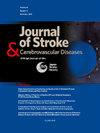卒中护士主导的急性卒中管理对治疗时间基准、静脉溶栓率和患者结局的影响:一项系统回顾和荟萃分析。
IF 2
4区 医学
Q3 NEUROSCIENCES
Journal of Stroke & Cerebrovascular Diseases
Pub Date : 2025-02-01
DOI:10.1016/j.jstrokecerebrovasdis.2024.108216
引用次数: 0
摘要
多学科卒中团队,包括卒中护士,证明在提供最佳急性缺血性卒中(AIS)管理方面是有效的。本系统综述和荟萃分析批判性地综合了现有的研究,以评估卒中护士参与对治疗时间基准和患者预后的影响。方法:各数据库的数据构成文献的主要来源,使用相关工具评估偏倚风险和文章质量。主要终点是3个月时从门到针(DTN)的时间、死亡率和良好的功能结局(mRS 0 - 2)。次要终点包括不同的治疗时间指标、IVT率和住院时间(LOS)。结果:我们筛选了截至2023年9月发表的235项研究,最终将8项纳入我们的分析。卒中护理干预与DTN时间减少显著相关(标准均差[SMD] = -19.71分钟;95% CI = [-31.45,-7.97]),三个月死亡率降低(优势比[OR] = 0.56;95% CI = [0.37,0.85])和改善的功能结局(OR = 1.33;95% ci = [1.03,1.71])。IVT率显著升高(OR = 1.52;95% CI = [1.01,2.28])。然而,LOS具有可比性(SMD = -0.45天;95% CI = [-1.11,0.21])。结论:我们的研究强调了在急性卒中团队中加入卒中护士的优势,减少了治疗时间,增加了IVT率,提高了患者的预后。它强调了跨专业卒中团队和循证护理的重要性,以确保在不同的医疗保健环境中公平获得高质量的卒中护理。本文章由计算机程序翻译,如有差异,请以英文原文为准。
Effects of stroke nurse-led acute stroke management on treatment time benchmarks, intravenous thrombolysis rates, and patient outcomes: A systematic review and meta-analysis
Introduction
Multidisciplinary stroke teams, including a stroke nurse, prove effective in delivering optimal acute ischemic stroke (AIS) management. This systematic review and meta-analysis critically synthesize existing studies to assess the impact of stroke nurse involvement on treatment time benchmarks and patient outcomes.
Method
Data from various databases constituted the primary sources of literature, and the risk of bias and article quality were evaluated using relevant tools. Primary endpoints were door-to-needle (DTN) time, mortality, and good functional outcomes (mRS 0 – 2) at three months. Secondary endpoints included varied treatment time metrics, IVT rates, and length of hospital stay (LOS).
Results
We screened 235 studies published up to September 2023 and ultimately included eight in our analysis. The stroke nurse intervention was significantly associated with a decrease in DTN time (Standard Mean Difference [SMD] = –19.71 min; 95 % CI = [–31.45, –7.97]), reduced three-month mortality rates (Odds Ratio [OR] = 0.56; 95 % CI = [0.37, 0.85]) and improved functional outcomes (OR = 1.33; 95 % CI = [1.03, 1.71]). The IVT rate significantly increased (OR = 1.52; 95 % CI = [1.01, 2.28]) with stroke nurse intervention. However, LOS was comparable (SMD = –0.45 days; 95 % CI = [–1.11, 0.21]) between scenarios with and without stroke nurse involvement.
Conclusions
Our study emphasizes the advantages of including stroke nurses in acute stroke teams, leading to reduced treatment times, increased IVT rates, and enhanced patient outcomes. It highlights the importance of inter-professional stroke teams and evidence-based nursing care to ensure equitable access to high-quality stroke care across diverse healthcare settings.
求助全文
通过发布文献求助,成功后即可免费获取论文全文。
去求助
来源期刊

Journal of Stroke & Cerebrovascular Diseases
Medicine-Surgery
CiteScore
5.00
自引率
4.00%
发文量
583
审稿时长
62 days
期刊介绍:
The Journal of Stroke & Cerebrovascular Diseases publishes original papers on basic and clinical science related to the fields of stroke and cerebrovascular diseases. The Journal also features review articles, controversies, methods and technical notes, selected case reports and other original articles of special nature. Its editorial mission is to focus on prevention and repair of cerebrovascular disease. Clinical papers emphasize medical and surgical aspects of stroke, clinical trials and design, epidemiology, stroke care delivery systems and outcomes, imaging sciences and rehabilitation of stroke. The Journal will be of special interest to specialists involved in caring for patients with cerebrovascular disease, including neurologists, neurosurgeons and cardiologists.
 求助内容:
求助内容: 应助结果提醒方式:
应助结果提醒方式:


